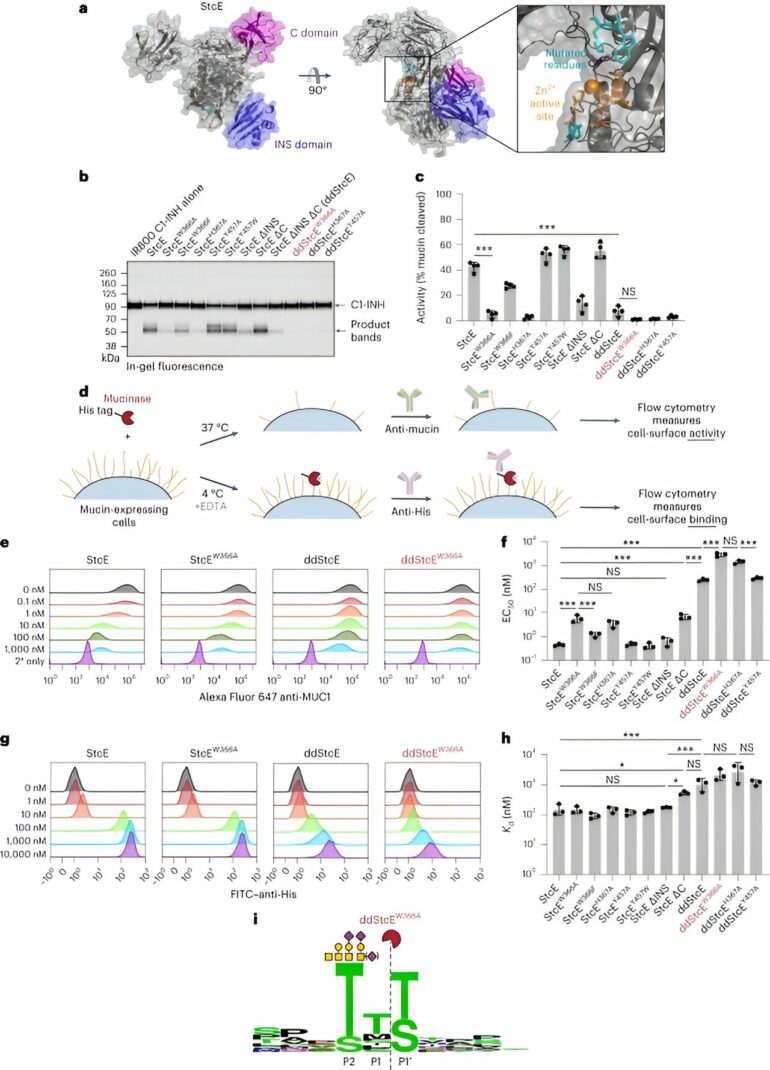Cancer cells can evade the body’s immune defenses by exploiting a normally helpful and ubiquitous group of molecules known as mucins. Now, Stanford researchers have engineered a biomolecule that removes mucins specifically from cancer cells—a discovery that could play a significant role in future therapies for cancer.
Mucins are sugar-coated proteins whose primary function is to defend the body against physical insults and pathogens. But cancer cells can co-opt mucins to aid their survival. Cutting mucins off cancer cells is a plausible therapy, but mucins exist in various forms on every cell in mammalian bodies, so targeting mucins indiscriminately could have unforeseen side effects.
The solution devised by the Stanford-led research team is essentially an enzyme-based scissors composed of a mucinase—a protein-cutting enzyme (called a protease) that specifically cuts mucins—fused to a cancer-cell-targeting nanobody (an antibody fragment). This two-part biomolecule selectively targets and prunes only mucins associated with specific cancer cells.
This study, carried out in lab-grown human cancer cells and in mouse studies that simulated human breast and lung cancer, found that the biomolecule treatment significantly reduced tumor growth and increased survival. Their findings, published Aug. 3 in Nature Biotechnology, have broad applications as mucins are associated with many diseases, including cystic fibrosis, respiratory diseases, and viruses.
“We found that we could target this mucinase to cancer cells, use it to remove mucins from those cancer cells, and there was a therapeutic benefit,” said senior author Carolyn Bertozzi, the Anne T. and Robert M. Bass professor in Stanford’s School of Humanities and Sciences.
Graduate scholar Gabrielle “Gabby” Tender is co-lead author on the study with two former Bertozzi lab researchers—Kayvon Pedram, a group leader at HHMI’s Janelia Research Campus, and D. Judy Shon, a postdoctoral scholar at Caltech.
When good mucins go bad
Although cancer cells use mucins for nefarious purposes, mucins are generally good. But when mucins go bad, they’re awful.
“Mucins play important roles throughout the body, such as forming mucus in our gut and lungs, and protecting us from pathogens,” said Tender. “Cancers dial this natural process up to 11, hijacking the functions of mucins to protect themselves and spread throughout the body.”
This study investigated two functions of mucins associated with promoting cancer progression. The first helps cells survive in free-floating “low-adhesion” environments.
“Cancers metastasize and spread in the body—cancer cells break off, float to another part of the body, and take root,” Bertozzi said. “Traveling cancer cells need to survive in low-adhesion environments. Most cells cannot, but cells that have been modified by mucins can.”
The second function is to bind to checkpoint receptors, which are essentially immune system guard dogs that inspect cells in the body. Some cancer cells accessorize their cell surfaces with mucins that are coated with specific sugars that bind particularly well to these receptors. When this sugar-decorated mucin binds to checkpoint receptors, it indicates the cancer cell is not a threat and blocks the body’s immune response.
“This causes immune cells to ignore the cancer rather than destroying it as they should,” Tender explained.
Getting there is half the battle
The researchers’ mucin-seeking biomolecule is made of two parts fused together. The first part is a bacteria-derived mucinase that cleaves mucins. The second part is a cancer-specific nanobody that binds to a corresponding antigen on cancer cells.
The nanobody “parks the mucinase on the cancer cell,” said Bertozzi, the Baker Family Director of Sarafan ChEM-H. “This technology is part of our larger program at Sarafan ChEM-H on proximity-based medicines.” Proximity-based medicines herd biomolecules of interest to a certain region so a desired chemical reaction can happen nearby.
Bertozzi’s team has extensively studied bacterial proteases that cleave mucins. These “mucinases” cut when they encounter specific arrangements of peptides (amino acids) and glycans (sugars) in mucins. For this study, the researchers chose a mucinase called StcE (pronounced “sticky”), derived from the bacteria E. coli.
Bacterial enzymes are already used in treatments for cancer, such as childhood acute lymphoblastic leukemias. However, mucinases haven’t been tested as injectable therapeutics. So, the team needed to verify the StcE mucinase works and is safe. The team tested the StcE mucinase in mice and found that it worked, but it ravaged mucins throughout the body, verifying the need to target the mucinase to tumor-associated mucins.
Previous research by Bertozzi’s lab and others demonstrated that fusing antibodies to enzymes can target their activity to specific cells. But it requires engineering the enzyme to work a little less well, so it only cuts when near its target. Many mutations of the StcE mucinase later, the team created a version, called eStcE (“engineered sticky”), that met their needs.
The team selected a nanobody known as 5F7 for their biomolecule because it is well-studied and it corresponds to the antigen (called HER2) associated with breast, ovarian, and other cancers. The researchers designed two different orientations of the eStcE mucinase-HER2 nanobody combo and tested each for yield, stability, mucinase activity, and binding ability. The best-performing orientation was nicknamed αHER2-eStcE.
Next, the researchers tested the αHER2-eStcE biomolecule to see if it selectively killed the target cancer cells in a series of tests in lab dishes. Then they verified the biomolecule worked and was nontoxic in two different studies using mice. The first of these experiments simulated metastatic (spreading) lung cancer, and the second simulated human breast cancer as tumors located in the breast region of mice.
These studies showed the αHER2-eStcE biomolecule was effective on both mucins on tumors and metastasizing cells. In the studies in mice, the researchers found that the αHER2-eStcE treatment significantly reduced cancer growth and increased survival compared to the untreated group of mice.
Future directions
So how close does this study bring us to a new cancer therapy for humans? Closer, but not there yet.
“One major next step is to see if we can make a comparable targeted mucinase using a protease derived from humans,” said Bertozzi. “The one in this study isn’t derived from humans and so it has a higher risk of an unwanted immune response.”
Tender is currently working to develop such a human-derived mucinase.
Although more research is needed, this study represents a big step forward in cancer research.
“We have decades of evidence from cancer patients and experiments that mucins are important in cancer, but there was not that much that we could previously do to get rid of these mucins,” said Tender. “We were inspired that we finally have an approach to degrade mucins on cancer cells.”
More information:
Kayvon Pedram et al, Design of a mucin-selective protease for targeted degradation of cancer-associated mucins, Nature Biotechnology (2023). DOI: 10.1038/s41587-023-01840-6
Provided by
Stanford University
Citation:
Bioengineered tool unmasks cancer cells (2023, August 10)



